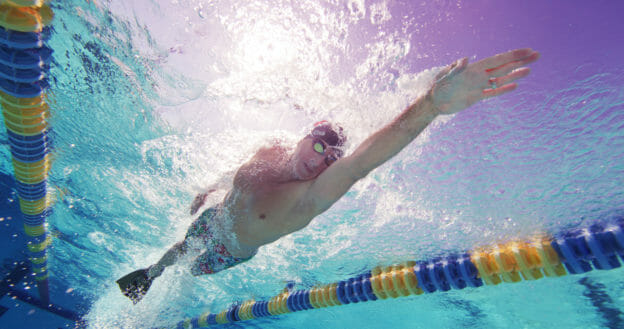Over the past two decades, the Hybrid or galloping (loping) technique of freestyle has become quite popular among elite swimmers. It is a particularly common swimming technique among elite males and for middle-distance events (100 and 200 freestyle). In a previous article, we discussed the features of the Hybrid freestyle technique and who should attempt to learn it. In this article we will discuss two great drills to learn hybrid freestyle.
Today, and in some recently released Race Club Webisodes, we feature two important drills for learning the Hybrid freestyle technique. The first drill is called the 6 kick/2 stroke drill and the second drill is called Over the wave/Under the wave drill.
In the 6 kick/2 stroke drill, the swimmer uses fins and holds one arm in front and the other at the side for six kicks. Before initiating the first stroke, the trailing arm is brought upwards with the elbow leading the way to a point directly above the swimmer’s shoulder. Once there, with the swimmer’s body rotated to that side, the recovering arm is driven quickly and forcefully down toward the water, entering at a slight angle and fully extended. The fingers and thumb should be squeezed tightly together at entry.
Once the recovering arm begins to descend towards the water, the leading arm begins to pull. By the time the recovering hand strikes the water, the pulling hand should be in the propulsion phase in the front quadrant. (For a full explanation of the six phases of the pulling cycle, please read Fundamentals of Fast Swimming).
When the pulling hand completes its underwater phase, it immediately goes into a recovery phase, albeit slower than with the other arm. Typically, both arms recover with the lower to middle octane energy level (moderate bend in the elbow). When this second arm strikes the water, it remains out front for six more kicks until the opposite arm descends forcefully toward the water.
In effect, the 6 kick/2 stroke drill enables the swimmer to deliver a 1-2 punch with the arms toward the water, with a long pause in between. This drill exaggerates the asymmetry of the Hybrid technique in every aspect.
The Over the wave/Under the wave drill emphasizes the strong coupling energy that swimmers generate with the Hybrid technique. In this drill, the swimmer purposefully lifts the head upward on the breath and then purposefully buries the head underwater after the breath. In effect, the swimmer pretends like he or she is swimming over the top of a wave, then underneath the wave. This is a technique that Olympian Janet Evans used back in the ’80s to set world records in the 400 and 800-meter freestyle events.
Although we do not advocate lifting the crown of the head for the breath in freestyle, as Janet did, this drill augments the coupling energy when coming down off of the breath. The Hybrid freestyle technique, with a faster recovery motion on the breathing side and the head dropping down under the surface, enables the swimmer to surge forward at this point in the stroke cycle, particularly when paired with a strong kick. With a higher elevation of the head and upper body, the swimmer feels more of the surge happening after coming down.
For a better Hybrid freestyle technique, practice using the 6 kick/2 stroke drill and the Over the wave/Under the wave drill. Then, to use the Hybrid technique more effectively in a race, start building a stronger kick.
We hope you enjoyed these two great drills to learn hybrid freestyle!
Yours in Swimming,
Gary Sr.

